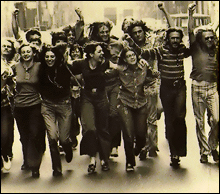
CHILDREN OF PARADISE: Peter Hujar’s iconic photograph for a Gay Liberation Front poster, circa 1970
|
The gay-rights movement has hit a brick wall. Yes, we have same-sex marriage in Massachusetts. Yes, the Supreme Court overturned state anti-sodomy laws. Yes, gay characters are all over mainstream TV. Still, after 35 years of slow, incremental progress, we are at a decisive crossroads. Simply put: to bring about real social change — dependent on truly transforming hearts and minds — it needs to reassess what kind of movement it wants to be. Will it be a movement that continues arguing, with diminishing success, merely for the rights of its own people — and even at that, only for those who, say, want to formalize a relationship? Or will it argue wholeheartedly, and without reservation, for a broader vision of justice and fairness that includes all Americans? If the movement does not choose the latter course, it runs the risk of becoming not just irrelevant, but a political stumbling block to progressive social change in general.
The right template for the future can be found in the gay-rights movement’s own history, in the insights of gay liberation — the radical, grassroots politics that emerged in June 1969, when queers rioted for three days in the streets of Greenwich Village to protest police harassment.
A week after the riots came to an end, the Gay Liberation Front (GLF) was formed. While its original membership included drag queens, ragtag queer youth, and old-time reformist gay activists, it was spearheaded by men and women seasoned in progressive, coalition-based politics with ties to labor, women’s-liberation, peace, economic-justice, and black- and Latino-liberation groups. In addition, almost everyone was engaged in some aspect of the national movement to stop the war in Vietnam. And — no surprise — all of these people were influenced by the late-’60s culture of anti-authoritarianism, sexual freedom, and personal liberation that was sweeping the country.
While I was not at the Stonewall riots (I think I was uptown at the New Yorker theater seeing a double bill of Ingmar Bergman films), I joined the GLF shortly after it formed. I was a 20-year-old lower-middle-class college student, active in Students for a Democratic Society (SDS) and anti-war protests. But the very idea of a politics that acknowledged — was actually based on affirming — my sexual desires was initially mind-boggling. This was the key, the cornerstone, that made all my other political work make sense. Of course, much of my, and my friends’, thinking was hopelessly naïve about both human nature and politics — particularly international politics — but on balance, it offered a more capacious and workable vision of justice than anything suggested by those who called simply for equal rights.
We gay liberationists have learned a lot over the past 35 years, as we’ve seen postcolonial-liberation struggles give rise to Islamic fundamentalism, watched a deeply reactionary, fundamentalist Christian constituency take center stage in US politics, endured the ravages of AIDS, and, yes, enjoyed some of the piecemeal gains made by the fight for gay rights. But it’s time to incorporate those lessons into the foundation we laid long ago — which provides a much sounder basis for the future than anything based on the limited notion of equal rights can offer.
ADVERTISEMENT
 |
Liberation now!
The GLF wasn’t fueled just by “sex, drugs, and rock and roll.” It saw itself as part of a worldwide political movement committed to both national and international social justice. Its very name — Gay Liberation Front — came from the newly formed Woman’s Liberation Front, which in turn was taken from the North Vietnamese’s National Liberation Front and the various calls for black liberation that had spun off from the civil-rights movement. These queer activists pursued coalitions with a wide range of progressive political groups, including the Black Panthers, National Organization of Women, anti–Vietnam War groups, and labor unions. Not all of these coalitions were successful — although Huey Newton, the Black Panthers leader, quite vocally supported gay liberation — but they marked the beginning of a coalition-based movement for gay rights that could have become larger and stronger. In many ways, the GLF had its roots in quasi-religious 19th-century-American utopian movements, such as Robert Dale Owen’s New Harmony, and John Humphrey Noyes’s Oneida Community. These communities were both abolitionist and pro-women’s-suffrage, while wedded to the ideas of personal freedom and group responsibility for social justice. For all its internationalism, at heart, the GLF was profoundly American.
But by the early 1970s, more-moderate, strategically limited, gay organizations formed. These groups — Gay Activists Alliance and National Gay Task Force were the largest (the now-powerful and very single-issue-centered Human Rights Campaign was not formed until almost a decade later) — focused on the far more narrowly defined concept of “gay rights.” They argued that freedom for gay men and lesbians would be best achieved not by addressing anti-gay discrimination as part of a larger pattern of discrimination in the US, but by focusing on specific legal inequalities that only affected homosexuals. This strategy resulted in a mindset of strict legalism that severely hindered the gay movement’s growth and effectiveness.